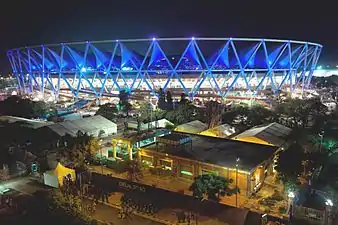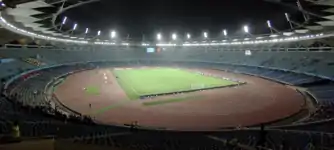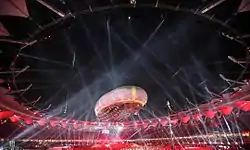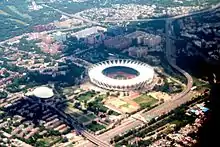Jawaharlal Nehru Stadium (Delhi)
Jawaharlal Nehru Stadium is a sports stadium located in New Delhi, India. It is named after the first Prime Minister of India. Primarily a venue for football and athletics, it is an all-seated 60,254 capacity stadium, designed and constructed to meet the international standards for stadiums set by the International Federation of Association Football (FIFA), the Asian Football Confederation (AFC), and the International Association of Athletics Federations (IAAF). It is the fourth largest stadium in India, 27th largest stadium in Asia and the 103rd largest stadium in the world, in terms of seating capacity.
 During 2010 Commonwealth Games | |

| |
| Address | New Delhi, Delhi, India - 110003 |
|---|---|
| Public transit | |
| Owner | Sports Authority of India[1] |
| Capacity | 60,254 |
| Field size | 106 m × 68 m (116 yd × 74 yd) |
| Surface | Grass, All-weather running track |
| Construction | |
| Built | 1982 |
| Opened | 1983 |
| Renovated | 2010 |
| Construction cost | INR ₹ 961 crores |
| Architect | Gerkan, Marg and Partners Schlaich Bergermann & Partner |
| Tenants | |
| |


The Jawaharlal Nehru Stadium was originally constructed by the Government of India to host the athletic events and ceremonies of the 1982 Asian Games.[2] It also hosted the 1989 Asian Championships in Athletics.
The stadium was substantially renovated and modernised for the 2010 Commonwealth Games, hosting all the track and field events and opening and closing ceremonies.[3] The cost of the renovation was around US$150 million, making it as the most expensive stadium ever built in India and South Asia. The stadium was redesigned by the German architectural companies Gerkan, Marg and Partners and Schlaich Bergermann & Partner.[4]
The stadium is a part of the Jawaharlal Nehru sports complex in central Delhi, which also houses the headquarters of the Sports Authority of India, the field arm of the Ministry of Youth Affairs and Sports, and the Indian Olympic Association.[5]
The stadium is used by the Indian national football team for international competition and Indian Athletics. Since 2014, It has also been the home ground of the Indian Super League football club Delhi Dynamos. The stadium hosted some matches of the 2017 FIFA U-17 World Cup.[6] The stadium can also hold music concerts with up to 100,000 spectators, and due to its oval shape, it is suitable to host other sporting events such as cricket. It will be used again for the 2020 FIFA U-17 Women's World Cup.
History
The Jawaharlal Nehru Stadium was constructed by the Government of India to host the 1982 Asian Games. A total of 3,411 athletes from 33 National Olympic Committees (NOCs) participated in these games, competing in 196 events in 21 sports and 23 disciplines. This was the first Asian Games to be held under the aegis of the Olympic Council of Asia. The stadium hosted the athletic events and opening and closing ceremonies. The capacity of the Jawaharlal Nehru Stadium was 78,000 during the games.[2]
The stadium also hosted the 1989 Asian Championships in Athletics. 19 nations participated in the championships.
Renovation
_design.jpg.webp)

Delhi was selected as the host city of the 2010 Commonwealth Games on 14 November 2003 during the CGF General Assembly in Montego Bay, Jamaica, defeating the competing bid from Hamilton, Canada.[7] In 2006, the Indian government decided to renovate the Jawaharlal Nehru Stadium for the Commonwealth Games.
The Indian government chose the design of the German architectural company Gerkan, Marg and Partners.[4] Renovation of the stadium started in 2007. Nearly 4,000 construction workers worked on the stadium in double shifts. The substantially remodelled and modernised stadium was inaugurated on 27 July 2010.[8] The stadium was given a new roof, improved seating, and other new facilities to meet international standards to allow it to host the athletic events and the opening and closing ceremonies of the 2010 Commonwealth Games.[3] The capacity of the stadium was reduced from 78,000 to 60,254. The cost of the renovation was around US$150 million (₹961 crores).[9]
The 53,800 m2 (579,000 sq ft) Teflon-coated roof, designed by the German structural engineering and consulting firm Schlaich Bergermann & Partner, was built at a cost of US$48 million (₹308 crores).[10] Taiyo Membrane Corporation supplied and installed the PTFE glass fibre fabric roof.[11] It is the one of the largest membrane roof system in the world. 8,500 tonnes of steel were used in the construction of the stadium's roof and its support structure. The support structure for the new roof is similar to London's Olympic Stadium. In case of emergency, the construction allows for all 60,000 spectators to be safely evacuated within 6 minutes.
A new Electro-Voice professional audio system by Bosch Communications was set up in the stadium.[12] A new 10-lane synthetic Olympic standard running track and a synthetic grass field were added. A 400-metre warm-up track was also constructed. A 150 metre long tunnel was constructed for the opening and closing ceremonies. The design is similar to Foshan Stadium in China, built by the same design company.
Two new venues were constructed next to the stadium for the Games: four synthetic greens for the lawn bowls event and a 2,500-seat gymnasium for the weightlifting event. The stadium is a part of the Jawaharlal Nehru sports complex which houses the headquarters of the Sports Authority of India, the field arm of the Ministry of Youth Affairs and Sports and Indian Olympic Association.[13]
2010 Commonwealth Games

Jawaharlal Nehru Stadium was the main venue for the 2010 Commonwealth Games. It hosted the opening and closing ceremonies as well as athletics events for the games. The stadium underwent massive redesign and reconstruction for the biggest multi-sport event hosted by India to that date. It was opened to the general public on 27 July 2010.[14]
In July 2010, the first-ever Asian All Asian Athletics Championship was held. Over 1,500 students from schools came to see the event. The opening ceremony of the 2010 Commonwealth Games has been held. Security for the ceremony used NSG, CRPF and Delhi police personnel. Tickets were checked by electronic ticket checking machine similar to the ones used in the Delhi Metro. There are over 350 CCTV cameras in the venue. Delhi was closed, in the sense that all the malls, shops, offices, and call-centers in Delhi were closed before and during the ceremony.
Football
I League matches have also been played here. The stadium was the main venue for the 2011 South Asian Football Federation Cup.
On 10 January 2012, the Government of India, and Audi, co-hosted a friendly football exhibition match between the Indian National Football Team and Bayern Munich at Jawaharlal Nehru stadium. In this one-sided affair, the German club has defeated Indian team by 4–0 in front of 30,000 spectators. This was the farewell match to Baichung Bhutia as Indian National Football Team captain.
Since 2014 Indian Super League season, it has been home ground for Delhi Dynamos FC.[15]
The stadium hosted 8 matches (including 2 Round of 16 matches) of the 2017 FIFA U-17 World Cup.[6] It will be used again for the 2020 FIFA U-17 Women's World Cup.
At the end of 2017–18 Indian Super League season, the football pitch in the stadium was named as "Best Pitch" in the league by ISL itself.[16]
Home of Indian National Football Team

The Indian team will play its home matches in the Nehru Stadium after it was handed over by Sports Ministry to the AIFF.[17] India's first match in the new stadium was to be played against UAE in 2014 FIFA World Cup qualification play-off in July 2011.[18] However, this match was shifted to Ambedkar Stadium because of the unplayable conditions at the Nehru stadium.[19] The 2011 SAFF Cup was held here from 2 - 11 Dec 2011, with the Indian team emerging victorious. The 2012 Nehru Cup was held from 23 August to 2 September at this venue.[20]
Concerts
The stadium played host to Amnesty International's Human Rights Now! Benefit Concert on 30 September 1988. The show was headlined by Bruce Springsteen & The E Street Band, and also featured Sting and Peter Gabriel, Tracy Chapman, Youssou N'Dour, and Ravi Shankar.
The project was led and managed by Mr. Ramji Lal from CPWD.
Michael Jackson was scheduled to perform 2 concerts at the stadium in December 1993 as a part of his Dangerous World Tour. Some tickets were also sold. This would have been the first time Jackson would have performed in India. MTV India and other T.V. channels played Jackson's music videos months before the concert which created mass hysteria and anticipation in the public for the concerts and Jackson's visit to India. Both the concerts were expected to be sold out. These two concerts were scheduled to be the last performances of the tour. Unfortunately the concerts in Delhi along with the dates for Indonesia and Australia were cancelled due to Jackson's health problems.
Cricket
The Stadium has hosted two One Day International matches featuring India against Australia in 1984 which incidentally, was the first day-night one day international match under floodlights to be held in India.[21] and South Africa in 1991, again the fixture being a day night one (also being the second ever day-night cricket match in India) . Batsman Kepler Wessels played in both the matches but for different countries and scored 107 for Australia and 90 for South Africa.[22]
A highly unusual feature of the ground was the inclusion of the running track as part of the cricket playing outfield area. The ICC's playing regulations eventually discontinued permission for the running track to be used in this way and thus the stadium was felt to be no longer suitable for cricket.
ODI matches hosted
| Team (A) | Team (B) | Winner | Margin | Year |
|---|---|---|---|---|
| By 48 runs | 1984 | |||
| By 8 wickets | 1991 |
List of Centuries
Key
- * denotes that the batsman was not out.
- Inns. denotes the number of the innings in the match.
- Balls denotes the number of balls faced in an innings.
- NR denotes that the number of balls was not recorded.
- Parentheses next to the player's score denotes his century number at Edgbaston.
- The column title Date refers to the date the match started.
- The column title Result refers to the player's team result
One Day Internationals
| No. | Score | Player | Team | Balls | Inns. | Opposing team | Date | Result |
|---|---|---|---|---|---|---|---|---|
| 1 | 107 | Kepler Wessels | 133 | 1 | 28 September 1984 | Won[23] | ||
| 2 | 109 | Ravi Shastri | 149 | 1 | 14 November 1991 | Won[24] | ||
| 3 | 105 | Sanjay Manjrekar | 82 | 1 | 14 November 1991 | Won[24] |
References
- http://www.sportsauthorityofindia.nic.in/index1.asp?ls_id=511
- "Olympic Council of Asia : 1982 Asian Games, New Delhi". www.ocasia.org. Archived from the original on 6 October 2015. Retrieved 15 September 2017.
- "Jawaharlal Nehru Sports Complex | XIX Commonwealth Games 2010 Delhi". d2010.thecgf.com. Retrieved 12 September 2017.
- "Jawaharlal Nehru Stadion in New Delhi". gmp Architekten von Gerkan, Marg und Partner. Retrieved 13 September 2017.
- "Sports Authority Of India" (PDF). Retrieved 13 August 2014.
- FIFA.com. "FIFA U-17 World Cup India 2017 - Jawaharlal Nehru Stadium - FIFA.com". FIFA.com. Retrieved 12 September 2017.
- "The Hindu : India to host 2010 Commonwealth Games". www.thehindu.com. Retrieved 13 September 2017.
- "Remodelled Nehru Stadium inaugurated". The Hindu. Special Correspondent. 27 July 2010. ISSN 0971-751X. Retrieved 13 September 2017.CS1 maint: others (link)
- "CWG scam: New stadium costs Rs 84 cr, JLN renovation Rs 961 cr!". The Economic Times. 4 August 2010. Retrieved 12 September 2017.
- "JNS Jawaharlal Nehru Stadium". www.sbp.de. Retrieved 15 September 2017.
- Duttagupta, Ishani (3 October 2010). "Taiyo designs & installs tensile membrane for stadia". The Economic Times. Retrieved 15 September 2017.
- Rahul Tripathi (5 October 2010). "JNS audio system heard loud and clear". The Times of India. Retrieved 22 February 2012.
- India, Sports Authority of. "Jawaharlal Nehru Stadium". sportsauthorityofindia.nic.in. Retrieved 14 September 2017.
- "Jawaharlal Nehru Sports Complex | XIX Commonwealth Games 2010 Delhi". d2010.thecgf.com. Retrieved 3 May 2017.
- www.indiansuperleague.com. "ISL - Indian Super League | Salt Lake Stadium, Kolkata". www.indiansuperleague.com. Archived from the original on 4 March 2016. Retrieved 3 May 2017.
- "ISL season awards".
- "Nehru stadium to turn into football hub: Maken". The Times of India. 15 April 2011.
- "Archived copy". Archived from the original on 13 March 2012. Retrieved 26 May 2011.CS1 maint: archived copy as title (link)
- "Indian National Team: Ambedkar Stadium To Host India V UAE 2014 World Cup Qualifier". Retrieved 28 June 2011.
- "2011 SAFF Championship Stadium Guides: New Delhi – Jawaharlal Nehru Stadium - Goal.com". Goal.com. 1 December 2011. Retrieved 3 May 2017.
- Wisden Almanack
- Wisden Almanack 1991
- "1st ODI (D/N), Australia tour of India at New Delhi, Sep 28 1984". ESPN Cricinfo. Retrieved 24 August 2019.
- "3rd ODI (D/N), South Africa tour of India at New Delhi, Nov 14 1991". ESPN Cricinfo. Retrieved 24 August 2019.
External links
| Wikimedia Commons has media related to Jawaharlal Nehru Stadium, New Delhi. |
- Jawaharlal Nehru Stadium - Sports Authority of India
- Jawaharlal Nehru Stadium - Tripadvisor
- Football temples of the world - India
- Cricinfo - Grounds - Jawaharlal Nehru Stadium, New Delhi
- World Stadiums Article
| Preceded by National Stadium (Thailand) Bangkok |
Asian Games Main Venue 1982 |
Succeeded by Seoul Olympic Stadium Seoul |
| Preceded by National Stadium (Singapore) Singapore |
Asian Athletics Championships Main Venue 1989 |
Succeeded by Stadium Merdeka Kuala Lumpur |
| Preceded by Melbourne Cricket Ground Melbourne |
Commonwealth Games Opening ceremonies Main Venue 2010 |
Succeeded by Celtic Park Glasgow |
| Preceded by Melbourne Cricket Ground Melbourne |
Commonwealth Games Athletics competitions Main venue 2010 |
Succeeded by Hampden Park Glasgow |